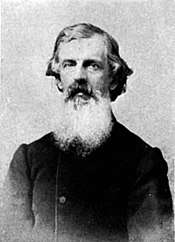Edward Tuckerman
Edward Tuckerman (December 7, 1817 in Boston, Massachusetts – March 15, 1886) was an American botanist and professor who made significant contributions to the study of lichens and other alpine plants. He was a founding member of the Natural History Society of Boston and most of his career was spent at Amherst College. He did the majority of his collecting on the slopes of Mount Washington in the White Mountains of New Hampshire. Tuckerman Ravine was named in his honor. The standard botanical author abbreviation Tuck. is applied to species he described.
Edward Tuckerman | |
|---|---|
 | |
| Born | December 7, 1817 Boston, Massachusetts |
| Died | March 15, 1886 (aged 68) |
| Nationality | American |
| Education | Boston Latin School |
| Alma mater | Union College Harvard Law School Harvard Divinity School |
| Spouse(s) | Sarah Cushing |
| Scientific career | |
| Fields | Botany |
| Institutions | Amherst College |
Early life and education
Tuckerman was the eldest son of a Boston merchant, also Edward Tuckerman, and Sophia (May) Tuckerman. He studied at Boston Latin School and then at his father's urging at Union College in Schenectady, which he entered as a sophomore and where he completed a BA in 1837 and to which he returned for his MA after taking a Law degree at Harvard in 1839, traveling in Germany and Scandinavia, and making the first of his botanical studies in the White Mountains.[1] In 1846, he returned to Harvard as a senior (telling the President he intended to correct his father's error in breaking the family tradition), completed a second BA in 1847, then two or three years later entered the Divinity School and graduated from there in 1852.[2] His brother was Frederick Goddard Tuckerman (1821–1873), the American poet and his first cousin was Henry Theodore Tuckerman (1813–1871), an American writer, essayist and critic.
Career
When Lewis and Clark went on their 1804-1806 expedition across the western United States, they collected many plant, seed, and flower species that had never been seen before. Lewis wrote notes about these species and they were put on scrap book paper. After Lewis supposedly committed suicide in 1809, dozens of his scrapbook pages were stolen by a botanist who was supposed to draw and classify the plants collected on the expedition. He took the papers to England to sell for money at an auction in 1842. Tuckerman noticed the auction and the significance of these papers. He bought them and then donated them to the Academy of Natural Sciences in Philadelphia.
After teaching at Union College, Tuckerman was a professor at Amherst College from 1854 until his death,[3] successively Lecturer in History, Professor of Oriental History, and from 1858 Professor of Botany.[4] Amherst awarded him an LLD.[5]
He was elected a member of the American Antiquarian Society in 1855.[6]
His first paper, on New England lichens, was given in 1838 or 1839.[5] In 1843, he published privately the first serious systematic analysis of the genus Carex, Enumeratio Methodica Caricum Quarundam. Tuckerman liked to write his botanical studies in Latin.[4][7] He also made the first systematic study of native Potamogeton, and after becoming Professor of Botany at Amherst, began preparing A Catalogue of Plants Growing without cultivation within 30 miles of Amherst College (published in 1875).[7] However, his main focus was lichens. He published a number of important studies in the field, drawing on both his own collecting and specimens sent to him from elsewhere, in particular by Charles Wright from Cuba.[8] His career culminated in the publication of Genera Lichenum: An Arrangement of the North American Lichens (1872) and Synopsis of the North American Lichens, Part 1 (1882).[9] His last botanical publication was in 1884, and he may have published anonymous theological articles after that.[10] Tuckerman did not accept that lichens are a combination of fungi and algae, a theory advanced late in his life.[11]
Personal life
Tuckerman was married to Sarah, daughter of Thomas Parkman Cushing, who was his father's business partner.[3][12] They had no children. Tuckerman died on March 15, 1886.
References
- Asa Gray, "Edward Tuckerman," Proceedings of the American Academy of Arts and Sciences 21 (1885-86) 539-47, repr. in Charles Sprague Sargent, ed., Scientific Papers of Asa Gray volume 2, pp. 491-98, p. 491.
- Gray, pp. 491-92.
- Daria D’Arienzo and Margaret R. Dakin, "An Even Better Home at Amherst," Amherst Magazine, Amherst College, Spring 2007. Accessed March 20, 2010.
- Joseph Ewan, "Frederick Pursh, 1774-1820, and his Botanical Associates," Proceedings of the American Philosophical Society vol. 96 no. 5 (1952) pp. 599-628, p. 625.
- Gray, p. 492.
- American Antiquarian Society Members Directory
- Gray, p. 493.
- Gray, p. 494: "from the Rocky Mountains, Texas, the Pacific coast, the Sandwich Islands [Hawai'i], and especially . . . the rich collections gathered in Cuba and elsewhere by the late Charles Wright."
- Gray, pp. 494-95.
- Gray, p. 497.
- Gray, p. 496.
- Ezra Scollay Stearns, History of Ashburnham, Massachusetts, from the Grant of Dorchester Canada to the Present Time, 1774-1836, Ashburnham: 1887, p. 663.
External links
| Wikisource has the text of a 1889 Appletons' Cyclopædia of American Biography article about Edward Tuckerman. |